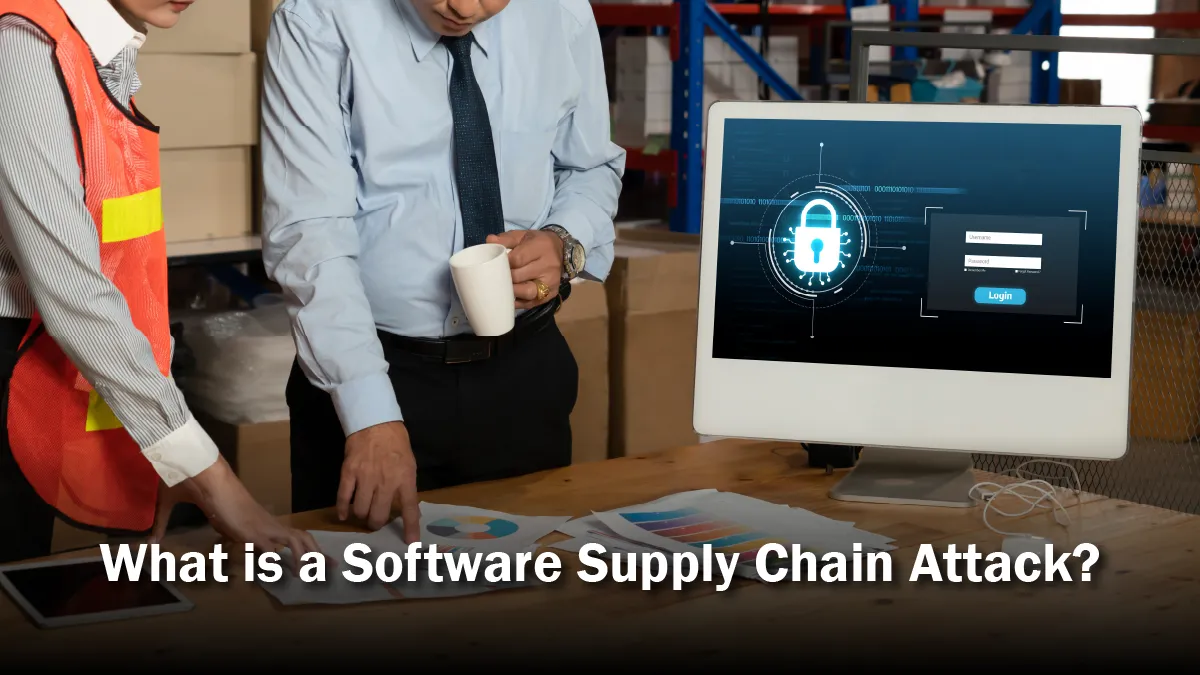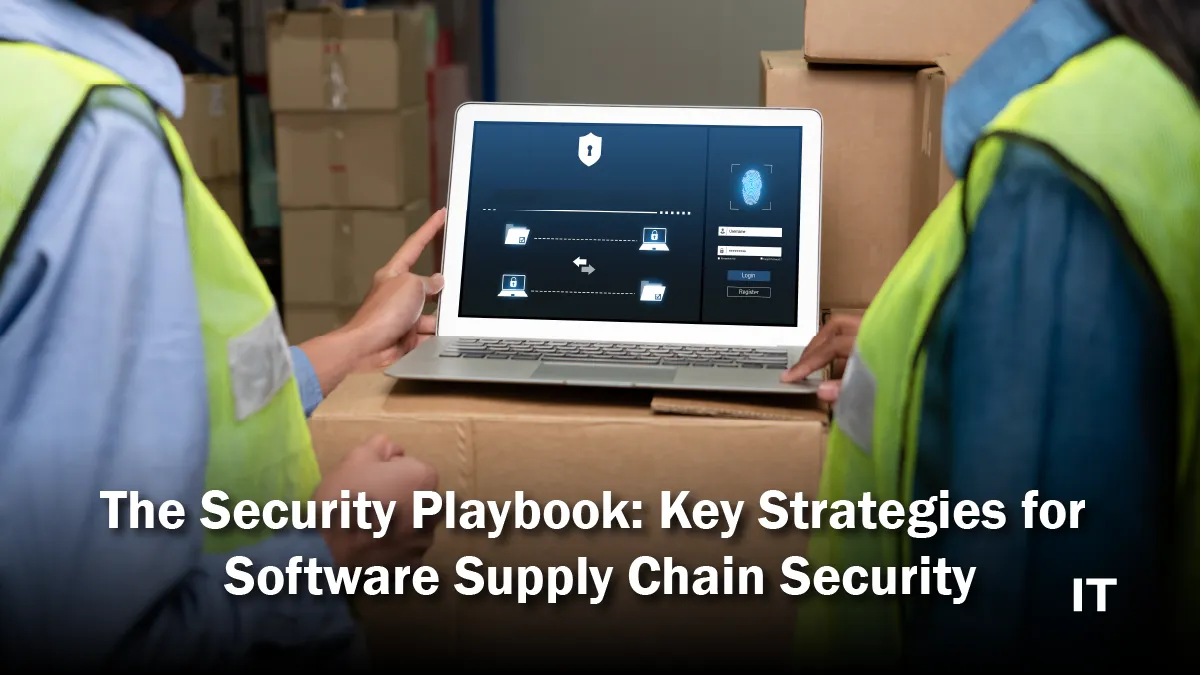Software supply chain security involves certain practices, tools, and technologies to protect software from vulnerabilities and potential security threats. It covers all aspects of the software development lifecycle (SDLC). This includes application development, third-party components, open-source libraries, and the CI/CD pipeline. It integrates best practices from both risk management and cybersecurity to defend against various threats to software integrity.
The software supply chain is complex. It includes many elements: infrastructure, hardware, OS, cloud services, and the developers who made them. Most software today is not developed from scratch. It is a mix of components, including open-source code, which can be vulnerable. Developers often have limited control over third-party code or changes made to software over time. Therefore, organizations must secure their software supply chains. This is essential to protect their apps from malware, unauthorized access, and other cyber threats.
Software supply chain attacks can severely impact both digital and physical infrastructures, highlighting the need for strong security. As attackers continue to exploit vulnerabilities within supply chains, organizations must implement comprehensive strategies to mitigate risks and effectively secure their software products.
What is a Software Supply Chain Attack?
 A software supply chain attack is a type of cyberattack. It occurs when an attacker exploits vulnerabilities in an external partner or service provider to access a system. Rather than directly targeting the application, attackers focus on compromising a component or service that interacts with the software. This approach can lead to unauthorized access and data exploitation. A prominent example of such an attack is the SolarWinds incident, where malicious code was embedded into legitimate software updates, impacting several organizations globally. Recognizing this threat is essential for developing effective defenses against it.
A software supply chain attack is a type of cyberattack. It occurs when an attacker exploits vulnerabilities in an external partner or service provider to access a system. Rather than directly targeting the application, attackers focus on compromising a component or service that interacts with the software. This approach can lead to unauthorized access and data exploitation. A prominent example of such an attack is the SolarWinds incident, where malicious code was embedded into legitimate software updates, impacting several organizations globally. Recognizing this threat is essential for developing effective defenses against it.
Combating Supply Chain Attacks
 Organizations face many supply chain threats. They include inserting malicious code during development, exploiting vulnerabilities in third-party libraries, and insecure configurations that allow unauthorized access. To combat these risks, companies should adopt a proactive risk management strategy. This should include regular audits of third-party components and monitoring for vulnerabilities in both proprietary and open-source software. They must also create plans to quickly respond to any breaches. These measures can help organizations defend against software supply chain attacks. They will ensure the integrity and security of their systems. Several countries are gearing up to strengthen their defences against software supply chain attacks. The executive order issued by the Biden administration in May 2021 aims to enhance the nation’s cybersecurity in response to sophisticated cyber threats.
Organizations face many supply chain threats. They include inserting malicious code during development, exploiting vulnerabilities in third-party libraries, and insecure configurations that allow unauthorized access. To combat these risks, companies should adopt a proactive risk management strategy. This should include regular audits of third-party components and monitoring for vulnerabilities in both proprietary and open-source software. They must also create plans to quickly respond to any breaches. These measures can help organizations defend against software supply chain attacks. They will ensure the integrity and security of their systems. Several countries are gearing up to strengthen their defences against software supply chain attacks. The executive order issued by the Biden administration in May 2021 aims to enhance the nation’s cybersecurity in response to sophisticated cyber threats.
Also Read: What is Enterprise Software and How Can It Help Your Business?
Executive Order on Cybersecurity
The executive order (EO 14028) is aimed at enhancing cybersecurity measures across federal agencies and private sectors. It highlights the urgent need for software supply chain security. It outlines several critical areas for improvement:
Security Measures: Establishing baseline security standards for software development.
Bill of Materials: Mandating that software suppliers provide a comprehensive software bill of materials (SBOM), which details all components used in their products.
Multi-factor Authentication (MFA): Requiring MFA to enhance access security.
Threat Information Sharing: Encouraging better collaboration between government and private sectors to share threat intelligence.
This EO directs agencies like the National Institute of Standards and Technology (NIST) to develop guidelines and best practices for securing software supply chains, ultimately aiming to reduce the risk associated with potential threats.
Key Security Measures for Software Supply Chains
Organizations can adopt various security measures to safeguard their software supply chains:
Establish Clear Access Controls
Organizations should set clear access controls. This ensures that individuals have the necessary permissions for their roles. This strategy helps minimize the risk of unauthorized access and accidental changes that could create vulnerabilities. Additionally, it is important for organizations to thoroughly evaluate third-party vendors before including them in their supply chain. This evaluation should assess their security practices and cybersecurity. It should confirm compliance with relevant standards and regulations. Combining these approaches can help organizations defend against supply chain threats.
Implementing MFA & Secure Code Practices
Adding an additional layer of security by requiring users to provide multiple forms of verification before accessing systems enhances protection against unauthorized access. Developers should adhere to secure coding guidelines that minimize common vulnerabilities such as SQL injection or cross-site scripting (XSS). This includes validating user inputs and sanitizing outputs. Additionally, organizations should regularly review and update their security protocols to adapt to new threats, ensuring ongoing protection. By fostering a culture of security awareness among developers and users, organizations can further strengthen their defenses against potential cyberattacks.
Conducting Security Testing
Regularly testing software for vulnerabilities helps identify and mitigate risks before they can be exploited. It helps in addressing vulnerabilities in both proprietary and third-party code. Organizations should utilize a variety of testing methodologies to ensure comprehensive coverage, including Static Application Security Testing (SAST), which analyzes source code for vulnerabilities without executing it; Dynamic Application Security Testing (DAST), which tests running applications for vulnerabilities during execution; and Interactive Application Security Testing (IAST), which combines elements from both SAST and DAST for a more thorough assessment. By integrating these testing methods into their CI/CD pipeline, organizations can prioritize security throughout the development lifecycle, ensuring that potential issues are identified and addressed early in the process. This proactive approach not only enhances the overall security posture of the software but also helps build trust with users by delivering more secure applications.
Utilizing Security Tools for Risk Management
Organizations should use Software Composition Analysis (SCA) tools to find known vulnerabilities in open-source components and third-party libraries within their applications. By incorporating SCA into the development process, teams can manage risks associated with external dependencies. Additionally, automated security tools can help quickly identify vulnerabilities in both the codebase and third-party components, allowing for a swift response to potential threats. Keeping track of all software components used in applications also helps organizations understand their exposure to vulnerabilities and manage risks better. By combining these strategies, organizations can strengthen their security measures and protect their software supply chains from attacks.
Ensuring Regulatory Compliance with SBOM
A SBOM is vital for transparency in software components. It boosts risk management and helps meet regulations. Organizations must also comply with established guidelines from NIST and other regulatory bodies to maintain a secure development environment. By creating an SBOM and adhering to these standards, organizations can effectively manage risks in their software supply chains and improve overall security.
Strengthening Security Teams and Training Employees
To effectively manage risks related to software supply chains, organizations must prioritize engaging dedicated security teams that focus on monitoring and mitigating potential threats. These teams are essential for identifying vulnerabilities and implementing protective measures. Additionally, conducting regular training sessions on security awareness empowers employees to recognize and respond to threats such as phishing attempts or social engineering attacks that could compromise the supply chain. By fostering a strong culture of security awareness and ensuring that both security teams and employees are well-informed, organizations can significantly enhance their defenses against cyber threats, ultimately creating a more resilient infrastructure.
Understanding Supply Chain Levels for Software Artifacts (SLSA)
The Supply Chain Levels for Software Artifacts (SLSA) framework provides a structured approach to enhancing software supply chain security. It categorizes different levels of assurance based on specific criteria that projects must meet:
Level 1: Basic integrity measures are implemented.
Level 2: Build processes are automated and verified.
Level 3: Provenance information is maintained, ensuring that all artifacts are traceable back to their source.
Level 4: Comprehensive security measures are in place, including rigorous testing and compliance checks.
By adhering to SLSA standards, organizations can significantly enhance their ability to manage risks associated with their software supply chains. This structured approach helps in identifying vulnerabilities and fosters greater accountability and transparency in software development processes. Ultimately, it helps create more secure applications and systems.
Leveraging Developer Tools
Organizations must use strong developer tools to manage security risks. These tools should support continuous integration and continuous deployment (CI/CD) practices, incorporating automated security checks at every stage of development. This integration ensures that vulnerabilities are identified early, reducing the risk of security issues in production. Furthermore, fostering collaboration between developers and security teams helps create a culture of shared responsibility for security outcomes. By embedding security practices within the development process, organizations can enhance compliance with regulatory standards while minimizing potential vulnerabilities. This proactive approach not only streamlines the development workflow but also strengthens the overall security posture of the organization, enabling it to respond swiftly to emerging threats in an increasingly complex digital landscape. Using these developer tools helps teams build secure apps. It maintains trust with users and stakeholders.
Conclusion
As cyber threats evolve, organizations must prioritize software supply chain security as a key part of their cybersecurity strategy. The executive order provides a framework for improving practices across industries. By implementing strong security measures, responsibly engaging with open-source projects, using frameworks like SLSA, and adopting effective developer tools, organizations can significantly lower their risks related to software supply chains. Addressing the challenges of software development requires collaboration among all stakeholders involved in creating and managing software products. By working together, developers, security teams, and regulatory bodies can build resilient systems that withstand emerging threats in our interconnected digital world.
































